ASS1031 Introducing Academic Skills Online Test Content
VerifiedAdded on 2023/06/07
|7
|2912
|494
AI Summary
This is a 60-minute online test that will assess your ability to format and cite references appropriately both in-text and via a reference list. It will also test your ability to judge what type of reference materials should be consulted for various academic purposes. The test consists of 20 multiple choice questions and is a summative assessment that contributes to 20% of your final grade. The examples are formatted in the Harvard referencing style.
Contribute Materials
Your contribution can guide someone’s learning journey. Share your
documents today.
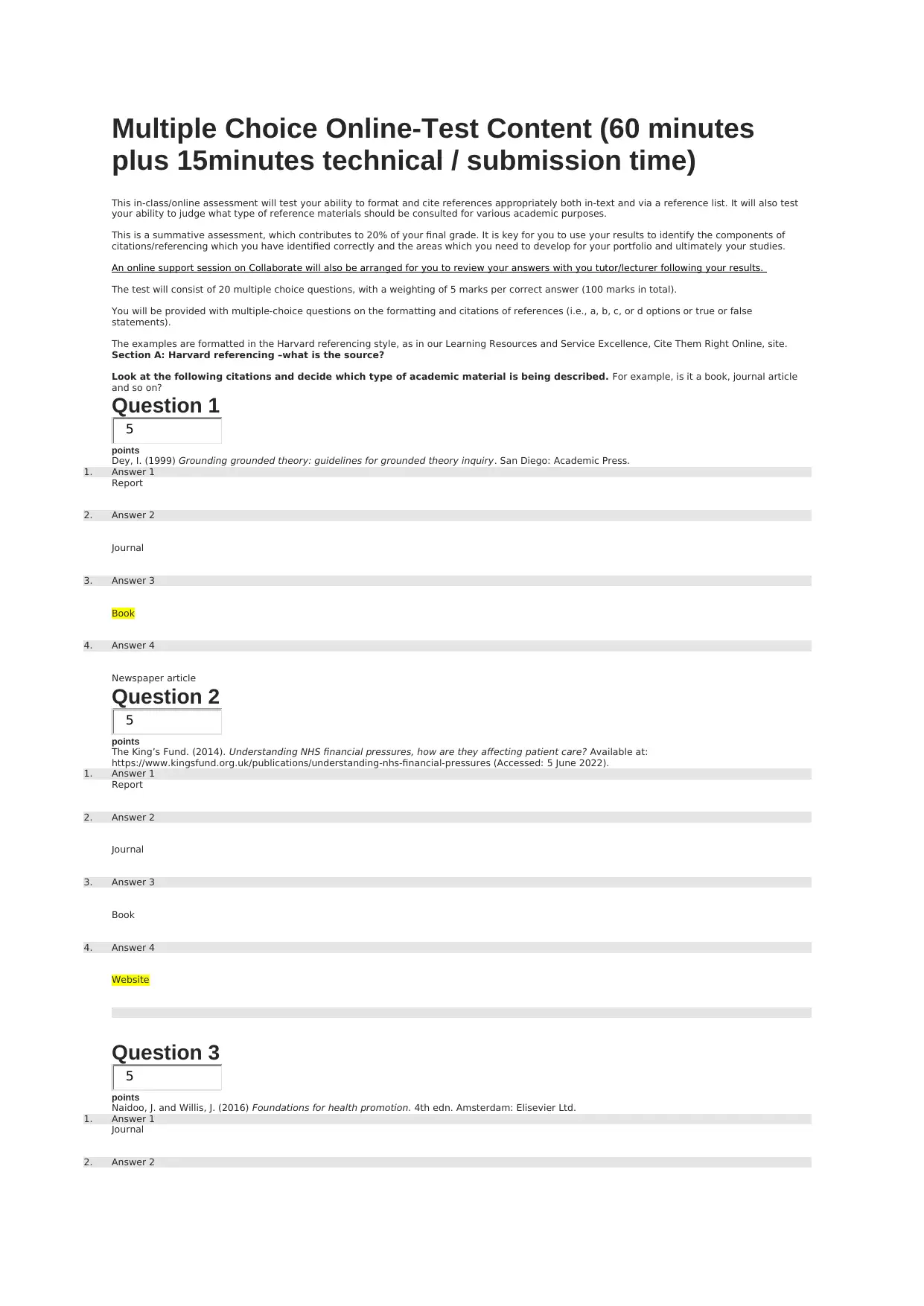
Multiple Choice Online-Test Content (60 minutes
plus 15minutes technical / submission time)
This in-class/online assessment will test your ability to format and cite references appropriately both in-text and via a reference list. It will also test
your ability to judge what type of reference materials should be consulted for various academic purposes.
This is a summative assessment, which contributes to 20% of your final grade. It is key for you to use your results to identify the components of
citations/referencing which you have identified correctly and the areas which you need to develop for your portfolio and ultimately your studies.
An online support session on Collaborate will also be arranged for you to review your answers with you tutor/lecturer following your results.
The test will consist of 20 multiple choice questions, with a weighting of 5 marks per correct answer (100 marks in total).
You will be provided with multiple-choice questions on the formatting and citations of references (i.e., a, b, c, or d options or true or false
statements).
The examples are formatted in the Harvard referencing style, as in our Learning Resources and Service Excellence, Cite Them Right Online, site.
Section A: Harvard referencing –what is the source?
Look at the following citations and decide which type of academic material is being described. For example, is it a book, journal article
and so on?
Question 1
points
Dey, I. (1999) Grounding grounded theory: guidelines for grounded theory inquiry. San Diego: Academic Press.
1. Answer 1
Report
2. Answer 2
Journal
3. Answer 3
Book
4. Answer 4
Newspaper article
Question 2
points
The King’s Fund. (2014). Understanding NHS financial pressures, how are they affecting patient care? Available at:
https://www.kingsfund.org.uk/publications/understanding-nhs-financial-pressures (Accessed: 5 June 2022).
1. Answer 1
Report
2. Answer 2
Journal
3. Answer 3
Book
4. Answer 4
Website
Question 3
points
Naidoo, J. and Willis, J. (2016) Foundations for health promotion. 4th edn. Amsterdam: Elisevier Ltd.
1. Answer 1
Journal
2. Answer 2
5
5
5
plus 15minutes technical / submission time)
This in-class/online assessment will test your ability to format and cite references appropriately both in-text and via a reference list. It will also test
your ability to judge what type of reference materials should be consulted for various academic purposes.
This is a summative assessment, which contributes to 20% of your final grade. It is key for you to use your results to identify the components of
citations/referencing which you have identified correctly and the areas which you need to develop for your portfolio and ultimately your studies.
An online support session on Collaborate will also be arranged for you to review your answers with you tutor/lecturer following your results.
The test will consist of 20 multiple choice questions, with a weighting of 5 marks per correct answer (100 marks in total).
You will be provided with multiple-choice questions on the formatting and citations of references (i.e., a, b, c, or d options or true or false
statements).
The examples are formatted in the Harvard referencing style, as in our Learning Resources and Service Excellence, Cite Them Right Online, site.
Section A: Harvard referencing –what is the source?
Look at the following citations and decide which type of academic material is being described. For example, is it a book, journal article
and so on?
Question 1
points
Dey, I. (1999) Grounding grounded theory: guidelines for grounded theory inquiry. San Diego: Academic Press.
1. Answer 1
Report
2. Answer 2
Journal
3. Answer 3
Book
4. Answer 4
Newspaper article
Question 2
points
The King’s Fund. (2014). Understanding NHS financial pressures, how are they affecting patient care? Available at:
https://www.kingsfund.org.uk/publications/understanding-nhs-financial-pressures (Accessed: 5 June 2022).
1. Answer 1
Report
2. Answer 2
Journal
3. Answer 3
Book
4. Answer 4
Website
Question 3
points
Naidoo, J. and Willis, J. (2016) Foundations for health promotion. 4th edn. Amsterdam: Elisevier Ltd.
1. Answer 1
Journal
2. Answer 2
5
5
5
Secure Best Marks with AI Grader
Need help grading? Try our AI Grader for instant feedback on your assignments.
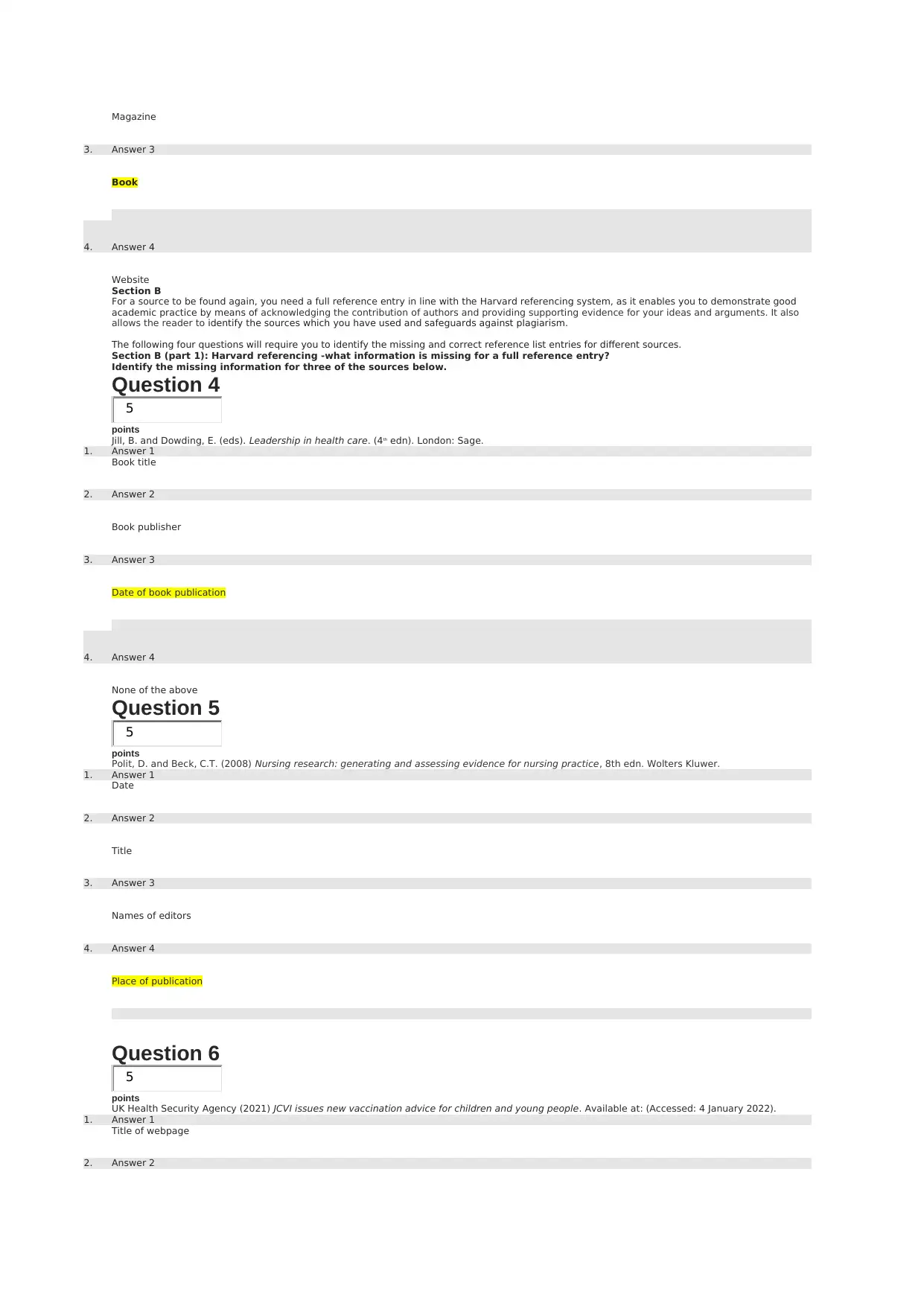
Magazine
3. Answer 3
Book
4. Answer 4
Website
Section B
For a source to be found again, you need a full reference entry in line with the Harvard referencing system, as it enables you to demonstrate good
academic practice by means of acknowledging the contribution of authors and providing supporting evidence for your ideas and arguments. It also
allows the reader to identify the sources which you have used and safeguards against plagiarism.
The following four questions will require you to identify the missing and correct reference list entries for different sources.
Section B (part 1): Harvard referencing -what information is missing for a full reference entry?
Identify the missing information for three of the sources below.
Question 4
points
Jill, B. and Dowding, E. (eds). Leadership in health care. (4th edn). London: Sage.
1. Answer 1
Book title
2. Answer 2
Book publisher
3. Answer 3
Date of book publication
4. Answer 4
None of the above
Question 5
points
Polit, D. and Beck, C.T. (2008) Nursing research: generating and assessing evidence for nursing practice, 8th edn. Wolters Kluwer.
1. Answer 1
Date
2. Answer 2
Title
3. Answer 3
Names of editors
4. Answer 4
Place of publication
Question 6
points
UK Health Security Agency (2021) JCVI issues new vaccination advice for children and young people. Available at: (Accessed: 4 January 2022).
1. Answer 1
Title of webpage
2. Answer 2
5
5
5
3. Answer 3
Book
4. Answer 4
Website
Section B
For a source to be found again, you need a full reference entry in line with the Harvard referencing system, as it enables you to demonstrate good
academic practice by means of acknowledging the contribution of authors and providing supporting evidence for your ideas and arguments. It also
allows the reader to identify the sources which you have used and safeguards against plagiarism.
The following four questions will require you to identify the missing and correct reference list entries for different sources.
Section B (part 1): Harvard referencing -what information is missing for a full reference entry?
Identify the missing information for three of the sources below.
Question 4
points
Jill, B. and Dowding, E. (eds). Leadership in health care. (4th edn). London: Sage.
1. Answer 1
Book title
2. Answer 2
Book publisher
3. Answer 3
Date of book publication
4. Answer 4
None of the above
Question 5
points
Polit, D. and Beck, C.T. (2008) Nursing research: generating and assessing evidence for nursing practice, 8th edn. Wolters Kluwer.
1. Answer 1
Date
2. Answer 2
Title
3. Answer 3
Names of editors
4. Answer 4
Place of publication
Question 6
points
UK Health Security Agency (2021) JCVI issues new vaccination advice for children and young people. Available at: (Accessed: 4 January 2022).
1. Answer 1
Title of webpage
2. Answer 2
5
5
5
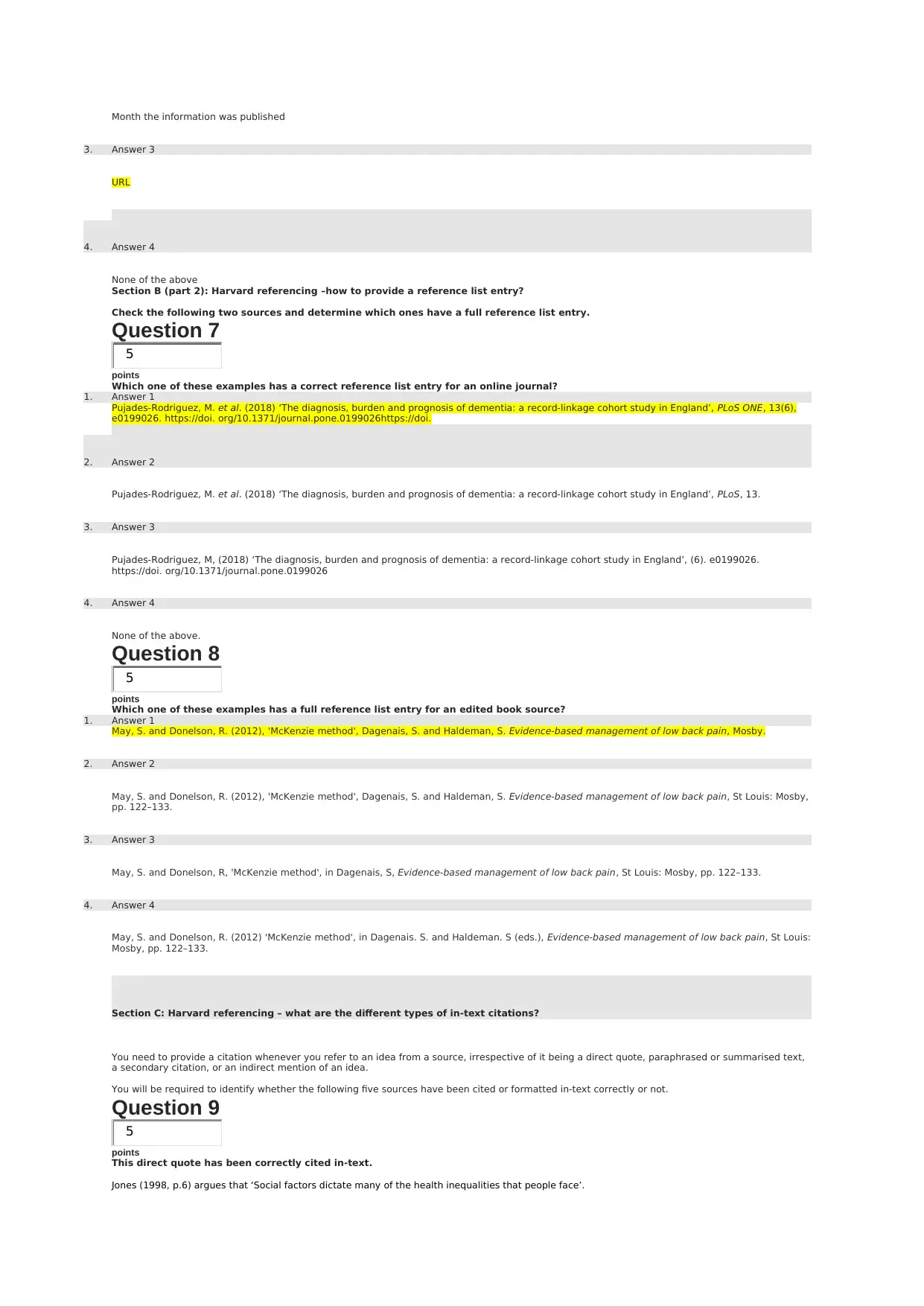
Month the information was published
3. Answer 3
URL
4. Answer 4
None of the above
Section B (part 2): Harvard referencing –how to provide a reference list entry?
Check the following two sources and determine which ones have a full reference list entry.
Question 7
points
Which one of these examples has a correct reference list entry for an online journal?
1. Answer 1
Pujades-Rodriguez, M. et al. (2018) ‘The diagnosis, burden and prognosis of dementia: a record-linkage cohort study in England’, PLoS ONE, 13(6),
e0199026. https://doi. org/10.1371/journal.pone.0199026https://doi.
2. Answer 2
Pujades-Rodriguez, M. et al. (2018) ‘The diagnosis, burden and prognosis of dementia: a record-linkage cohort study in England’, PLoS, 13.
3. Answer 3
Pujades-Rodriguez, M, (2018) ‘The diagnosis, burden and prognosis of dementia: a record-linkage cohort study in England’, (6). e0199026.
https://doi. org/10.1371/journal.pone.0199026
4. Answer 4
None of the above.
Question 8
points
Which one of these examples has a full reference list entry for an edited book source?
1. Answer 1
May, S. and Donelson, R. (2012), 'McKenzie method', Dagenais, S. and Haldeman, S. Evidence-based management of low back pain, Mosby.
2. Answer 2
May, S. and Donelson, R. (2012), 'McKenzie method', Dagenais, S. and Haldeman, S. Evidence-based management of low back pain, St Louis: Mosby,
pp. 122–133.
3. Answer 3
May, S. and Donelson, R, 'McKenzie method', in Dagenais, S, Evidence-based management of low back pain, St Louis: Mosby, pp. 122–133.
4. Answer 4
May, S. and Donelson, R. (2012) 'McKenzie method', in Dagenais. S. and Haldeman. S (eds.), Evidence-based management of low back pain, St Louis:
Mosby, pp. 122–133.
Section C: Harvard referencing – what are the different types of in-text citations?
You need to provide a citation whenever you refer to an idea from a source, irrespective of it being a direct quote, paraphrased or summarised text,
a secondary citation, or an indirect mention of an idea.
You will be required to identify whether the following five sources have been cited or formatted in-text correctly or not.
Question 9
points
This direct quote has been correctly cited in-text.
Jones (1998, p.6) argues that ‘Social factors dictate many of the health inequalities that people face’.
5
5
5
3. Answer 3
URL
4. Answer 4
None of the above
Section B (part 2): Harvard referencing –how to provide a reference list entry?
Check the following two sources and determine which ones have a full reference list entry.
Question 7
points
Which one of these examples has a correct reference list entry for an online journal?
1. Answer 1
Pujades-Rodriguez, M. et al. (2018) ‘The diagnosis, burden and prognosis of dementia: a record-linkage cohort study in England’, PLoS ONE, 13(6),
e0199026. https://doi. org/10.1371/journal.pone.0199026https://doi.
2. Answer 2
Pujades-Rodriguez, M. et al. (2018) ‘The diagnosis, burden and prognosis of dementia: a record-linkage cohort study in England’, PLoS, 13.
3. Answer 3
Pujades-Rodriguez, M, (2018) ‘The diagnosis, burden and prognosis of dementia: a record-linkage cohort study in England’, (6). e0199026.
https://doi. org/10.1371/journal.pone.0199026
4. Answer 4
None of the above.
Question 8
points
Which one of these examples has a full reference list entry for an edited book source?
1. Answer 1
May, S. and Donelson, R. (2012), 'McKenzie method', Dagenais, S. and Haldeman, S. Evidence-based management of low back pain, Mosby.
2. Answer 2
May, S. and Donelson, R. (2012), 'McKenzie method', Dagenais, S. and Haldeman, S. Evidence-based management of low back pain, St Louis: Mosby,
pp. 122–133.
3. Answer 3
May, S. and Donelson, R, 'McKenzie method', in Dagenais, S, Evidence-based management of low back pain, St Louis: Mosby, pp. 122–133.
4. Answer 4
May, S. and Donelson, R. (2012) 'McKenzie method', in Dagenais. S. and Haldeman. S (eds.), Evidence-based management of low back pain, St Louis:
Mosby, pp. 122–133.
Section C: Harvard referencing – what are the different types of in-text citations?
You need to provide a citation whenever you refer to an idea from a source, irrespective of it being a direct quote, paraphrased or summarised text,
a secondary citation, or an indirect mention of an idea.
You will be required to identify whether the following five sources have been cited or formatted in-text correctly or not.
Question 9
points
This direct quote has been correctly cited in-text.
Jones (1998, p.6) argues that ‘Social factors dictate many of the health inequalities that people face’.
5
5
5
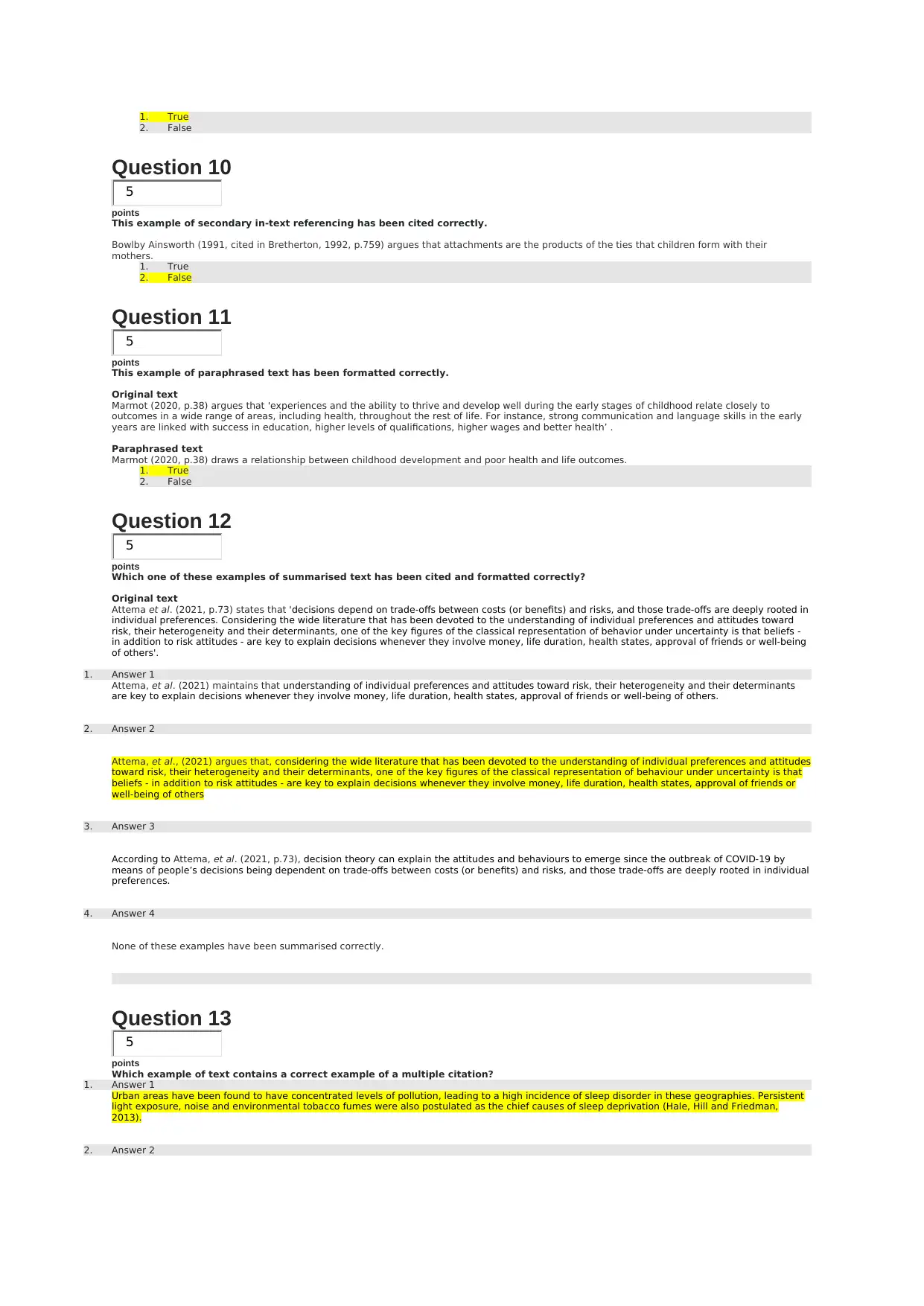
1. True
2. False
Question 10
points
This example of secondary in-text referencing has been cited correctly.
Bowlby Ainsworth (1991, cited in Bretherton, 1992, p.759) argues that attachments are the products of the ties that children form with their
mothers.
1. True
2. False
Question 11
points
This example of paraphrased text has been formatted correctly.
Original text
Marmot (2020, p.38) argues that 'experiences and the ability to thrive and develop well during the early stages of childhood relate closely to
outcomes in a wide range of areas, including health, throughout the rest of life. For instance, strong communication and language skills in the early
years are linked with success in education, higher levels of qualifications, higher wages and better health’ .
Paraphrased text
Marmot (2020, p.38) draws a relationship between childhood development and poor health and life outcomes.
1. True
2. False
Question 12
points
Which one of these examples of summarised text has been cited and formatted correctly?
Original text
Attema et al. (2021, p.73) states that 'decisions depend on trade-offs between costs (or benefits) and risks, and those trade-offs are deeply rooted in
individual preferences. Considering the wide literature that has been devoted to the understanding of individual preferences and attitudes toward
risk, their heterogeneity and their determinants, one of the key figures of the classical representation of behavior under uncertainty is that beliefs -
in addition to risk attitudes - are key to explain decisions whenever they involve money, life duration, health states, approval of friends or well-being
of others'.
1. Answer 1
Attema, et al. (2021) maintains that understanding of individual preferences and attitudes toward risk, their heterogeneity and their determinants
are key to explain decisions whenever they involve money, life duration, health states, approval of friends or well-being of others.
2. Answer 2
Attema, et al., (2021) argues that, considering the wide literature that has been devoted to the understanding of individual preferences and attitudes
toward risk, their heterogeneity and their determinants, one of the key figures of the classical representation of behaviour under uncertainty is that
beliefs - in addition to risk attitudes - are key to explain decisions whenever they involve money, life duration, health states, approval of friends or
well-being of others
3. Answer 3
According to Attema, et al. (2021, p.73), decision theory can explain the attitudes and behaviours to emerge since the outbreak of COVID-19 by
means of people’s decisions being dependent on trade-offs between costs (or benefits) and risks, and those trade-offs are deeply rooted in individual
preferences.
4. Answer 4
None of these examples have been summarised correctly.
Question 13
points
Which example of text contains a correct example of a multiple citation?
1. Answer 1
Urban areas have been found to have concentrated levels of pollution, leading to a high incidence of sleep disorder in these geographies. Persistent
light exposure, noise and environmental tobacco fumes were also postulated as the chief causes of sleep deprivation (Hale, Hill and Friedman,
2013).
2. Answer 2
5
5
5
5
2. False
Question 10
points
This example of secondary in-text referencing has been cited correctly.
Bowlby Ainsworth (1991, cited in Bretherton, 1992, p.759) argues that attachments are the products of the ties that children form with their
mothers.
1. True
2. False
Question 11
points
This example of paraphrased text has been formatted correctly.
Original text
Marmot (2020, p.38) argues that 'experiences and the ability to thrive and develop well during the early stages of childhood relate closely to
outcomes in a wide range of areas, including health, throughout the rest of life. For instance, strong communication and language skills in the early
years are linked with success in education, higher levels of qualifications, higher wages and better health’ .
Paraphrased text
Marmot (2020, p.38) draws a relationship between childhood development and poor health and life outcomes.
1. True
2. False
Question 12
points
Which one of these examples of summarised text has been cited and formatted correctly?
Original text
Attema et al. (2021, p.73) states that 'decisions depend on trade-offs between costs (or benefits) and risks, and those trade-offs are deeply rooted in
individual preferences. Considering the wide literature that has been devoted to the understanding of individual preferences and attitudes toward
risk, their heterogeneity and their determinants, one of the key figures of the classical representation of behavior under uncertainty is that beliefs -
in addition to risk attitudes - are key to explain decisions whenever they involve money, life duration, health states, approval of friends or well-being
of others'.
1. Answer 1
Attema, et al. (2021) maintains that understanding of individual preferences and attitudes toward risk, their heterogeneity and their determinants
are key to explain decisions whenever they involve money, life duration, health states, approval of friends or well-being of others.
2. Answer 2
Attema, et al., (2021) argues that, considering the wide literature that has been devoted to the understanding of individual preferences and attitudes
toward risk, their heterogeneity and their determinants, one of the key figures of the classical representation of behaviour under uncertainty is that
beliefs - in addition to risk attitudes - are key to explain decisions whenever they involve money, life duration, health states, approval of friends or
well-being of others
3. Answer 3
According to Attema, et al. (2021, p.73), decision theory can explain the attitudes and behaviours to emerge since the outbreak of COVID-19 by
means of people’s decisions being dependent on trade-offs between costs (or benefits) and risks, and those trade-offs are deeply rooted in individual
preferences.
4. Answer 4
None of these examples have been summarised correctly.
Question 13
points
Which example of text contains a correct example of a multiple citation?
1. Answer 1
Urban areas have been found to have concentrated levels of pollution, leading to a high incidence of sleep disorder in these geographies. Persistent
light exposure, noise and environmental tobacco fumes were also postulated as the chief causes of sleep deprivation (Hale, Hill and Friedman,
2013).
2. Answer 2
5
5
5
5
Secure Best Marks with AI Grader
Need help grading? Try our AI Grader for instant feedback on your assignments.
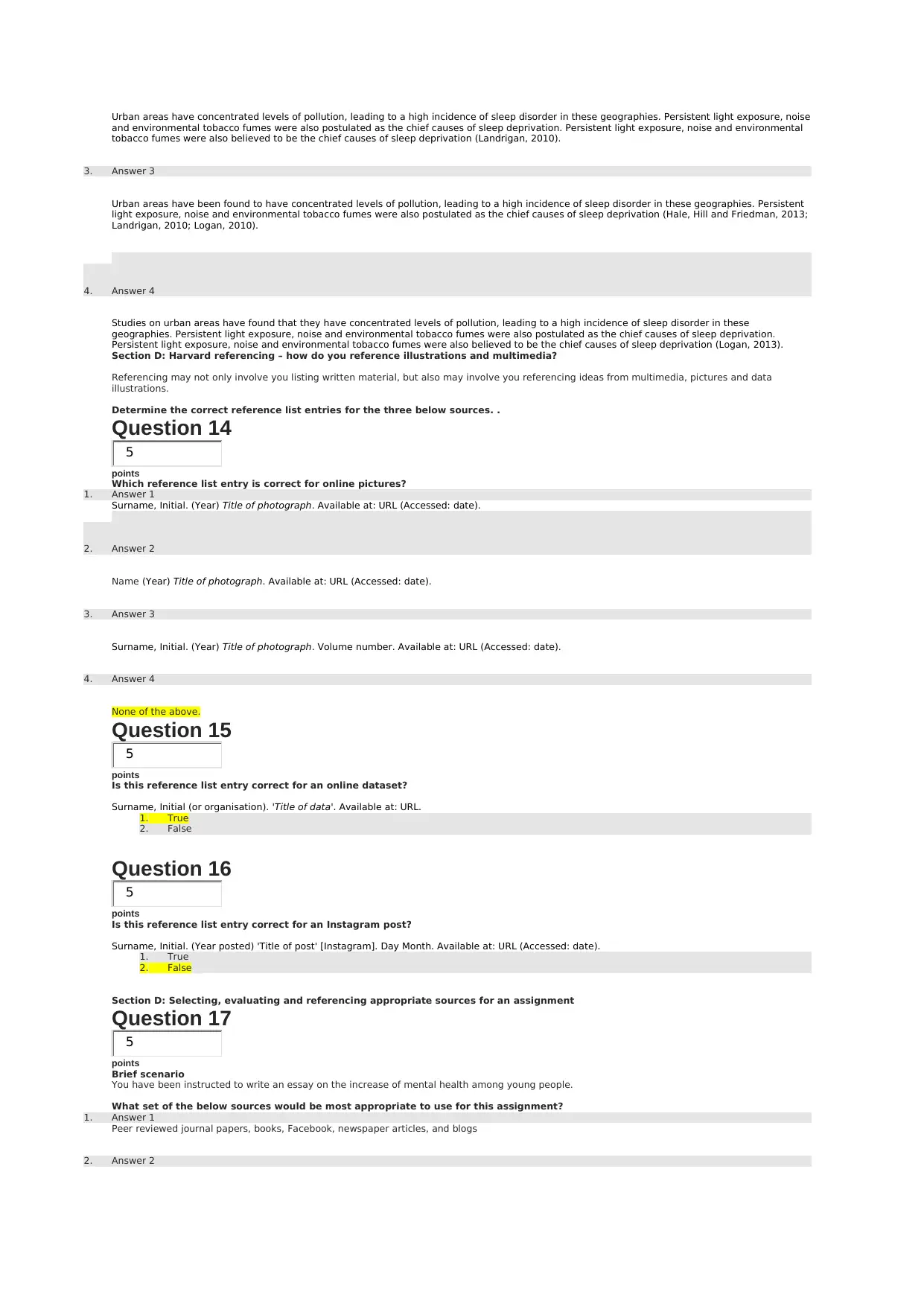
Urban areas have concentrated levels of pollution, leading to a high incidence of sleep disorder in these geographies. Persistent light exposure, noise
and environmental tobacco fumes were also postulated as the chief causes of sleep deprivation. Persistent light exposure, noise and environmental
tobacco fumes were also believed to be the chief causes of sleep deprivation (Landrigan, 2010).
3. Answer 3
Urban areas have been found to have concentrated levels of pollution, leading to a high incidence of sleep disorder in these geographies. Persistent
light exposure, noise and environmental tobacco fumes were also postulated as the chief causes of sleep deprivation (Hale, Hill and Friedman, 2013;
Landrigan, 2010; Logan, 2010).
4. Answer 4
Studies on urban areas have found that they have concentrated levels of pollution, leading to a high incidence of sleep disorder in these
geographies. Persistent light exposure, noise and environmental tobacco fumes were also postulated as the chief causes of sleep deprivation.
Persistent light exposure, noise and environmental tobacco fumes were also believed to be the chief causes of sleep deprivation (Logan, 2013).
Section D: Harvard referencing – how do you reference illustrations and multimedia?
Referencing may not only involve you listing written material, but also may involve you referencing ideas from multimedia, pictures and data
illustrations.
Determine the correct reference list entries for the three below sources. .
Question 14
points
Which reference list entry is correct for online pictures?
1. Answer 1
Surname, Initial. (Year) Title of photograph. Available at: URL (Accessed: date).
2. Answer 2
Name (Year) Title of photograph. Available at: URL (Accessed: date).
3. Answer 3
Surname, Initial. (Year) Title of photograph. Volume number. Available at: URL (Accessed: date).
4. Answer 4
None of the above.
Question 15
points
Is this reference list entry correct for an online dataset?
Surname, Initial (or organisation). 'Title of data'. Available at: URL.
1. True
2. False
Question 16
points
Is this reference list entry correct for an Instagram post?
Surname, Initial. (Year posted) 'Title of post' [Instagram]. Day Month. Available at: URL (Accessed: date).
1. True
2. False
Section D: Selecting, evaluating and referencing appropriate sources for an assignment
Question 17
points
Brief scenario
You have been instructed to write an essay on the increase of mental health among young people.
What set of the below sources would be most appropriate to use for this assignment?
1. Answer 1
Peer reviewed journal papers, books, Facebook, newspaper articles, and blogs
2. Answer 2
5
5
5
5
and environmental tobacco fumes were also postulated as the chief causes of sleep deprivation. Persistent light exposure, noise and environmental
tobacco fumes were also believed to be the chief causes of sleep deprivation (Landrigan, 2010).
3. Answer 3
Urban areas have been found to have concentrated levels of pollution, leading to a high incidence of sleep disorder in these geographies. Persistent
light exposure, noise and environmental tobacco fumes were also postulated as the chief causes of sleep deprivation (Hale, Hill and Friedman, 2013;
Landrigan, 2010; Logan, 2010).
4. Answer 4
Studies on urban areas have found that they have concentrated levels of pollution, leading to a high incidence of sleep disorder in these
geographies. Persistent light exposure, noise and environmental tobacco fumes were also postulated as the chief causes of sleep deprivation.
Persistent light exposure, noise and environmental tobacco fumes were also believed to be the chief causes of sleep deprivation (Logan, 2013).
Section D: Harvard referencing – how do you reference illustrations and multimedia?
Referencing may not only involve you listing written material, but also may involve you referencing ideas from multimedia, pictures and data
illustrations.
Determine the correct reference list entries for the three below sources. .
Question 14
points
Which reference list entry is correct for online pictures?
1. Answer 1
Surname, Initial. (Year) Title of photograph. Available at: URL (Accessed: date).
2. Answer 2
Name (Year) Title of photograph. Available at: URL (Accessed: date).
3. Answer 3
Surname, Initial. (Year) Title of photograph. Volume number. Available at: URL (Accessed: date).
4. Answer 4
None of the above.
Question 15
points
Is this reference list entry correct for an online dataset?
Surname, Initial (or organisation). 'Title of data'. Available at: URL.
1. True
2. False
Question 16
points
Is this reference list entry correct for an Instagram post?
Surname, Initial. (Year posted) 'Title of post' [Instagram]. Day Month. Available at: URL (Accessed: date).
1. True
2. False
Section D: Selecting, evaluating and referencing appropriate sources for an assignment
Question 17
points
Brief scenario
You have been instructed to write an essay on the increase of mental health among young people.
What set of the below sources would be most appropriate to use for this assignment?
1. Answer 1
Peer reviewed journal papers, books, Facebook, newspaper articles, and blogs
2. Answer 2
5
5
5
5
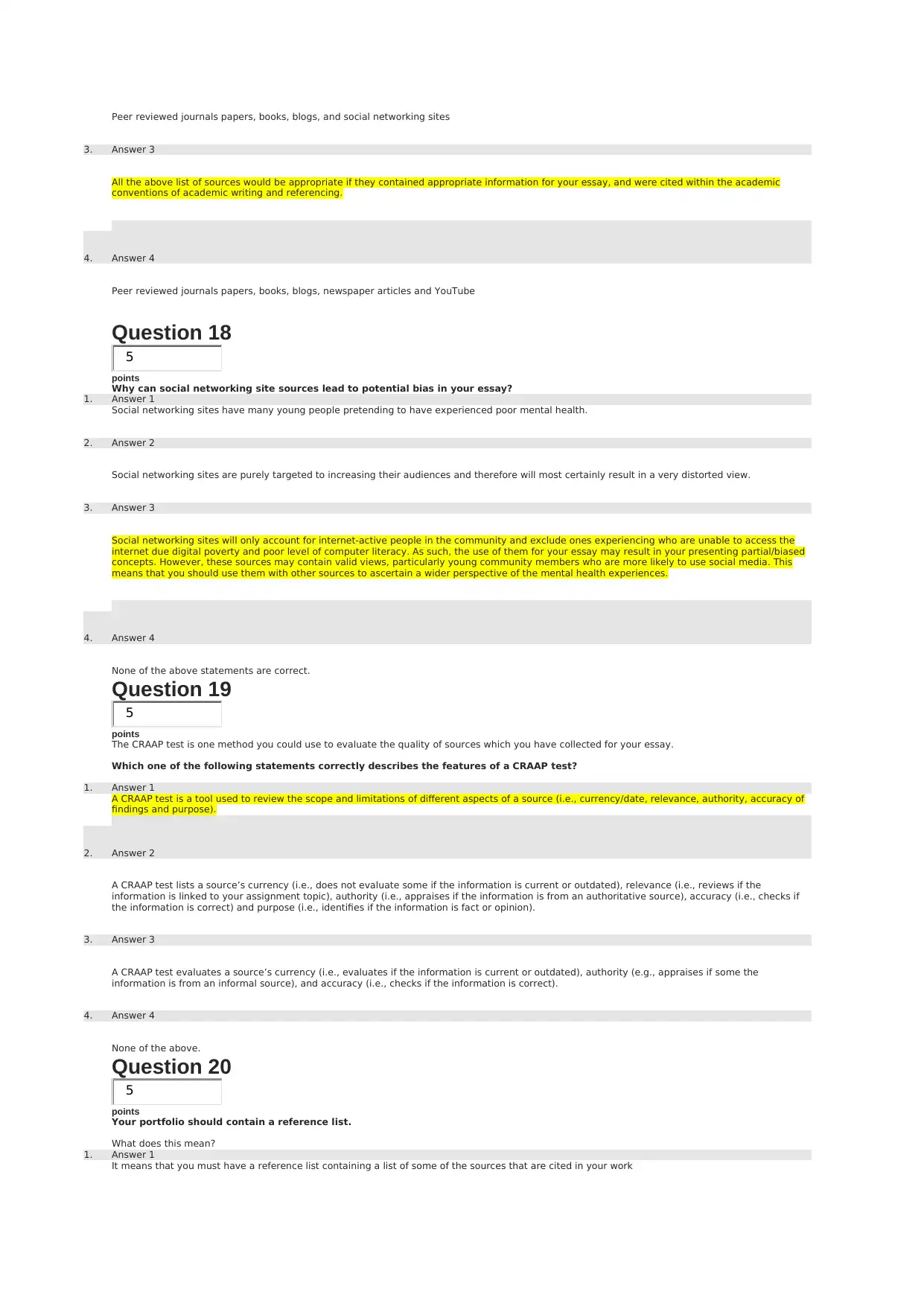
Peer reviewed journals papers, books, blogs, and social networking sites
3. Answer 3
All the above list of sources would be appropriate if they contained appropriate information for your essay, and were cited within the academic
conventions of academic writing and referencing.
4. Answer 4
Peer reviewed journals papers, books, blogs, newspaper articles and YouTube
Question 18
points
Why can social networking site sources lead to potential bias in your essay?
1. Answer 1
Social networking sites have many young people pretending to have experienced poor mental health.
2. Answer 2
Social networking sites are purely targeted to increasing their audiences and therefore will most certainly result in a very distorted view.
3. Answer 3
Social networking sites will only account for internet-active people in the community and exclude ones experiencing who are unable to access the
internet due digital poverty and poor level of computer literacy. As such, the use of them for your essay may result in your presenting partial/biased
concepts. However, these sources may contain valid views, particularly young community members who are more likely to use social media. This
means that you should use them with other sources to ascertain a wider perspective of the mental health experiences.
4. Answer 4
None of the above statements are correct.
Question 19
points
The CRAAP test is one method you could use to evaluate the quality of sources which you have collected for your essay.
Which one of the following statements correctly describes the features of a CRAAP test?
1. Answer 1
A CRAAP test is a tool used to review the scope and limitations of different aspects of a source (i.e., currency/date, relevance, authority, accuracy of
findings and purpose).
2. Answer 2
A CRAAP test lists a source’s currency (i.e., does not evaluate some if the information is current or outdated), relevance (i.e., reviews if the
information is linked to your assignment topic), authority (i.e., appraises if the information is from an authoritative source), accuracy (i.e., checks if
the information is correct) and purpose (i.e., identifies if the information is fact or opinion).
3. Answer 3
A CRAAP test evaluates a source’s currency (i.e., evaluates if the information is current or outdated), authority (e.g., appraises if some the
information is from an informal source), and accuracy (i.e., checks if the information is correct).
4. Answer 4
None of the above.
Question 20
points
Your portfolio should contain a reference list.
What does this mean?
1. Answer 1
It means that you must have a reference list containing a list of some of the sources that are cited in your work
5
5
5
3. Answer 3
All the above list of sources would be appropriate if they contained appropriate information for your essay, and were cited within the academic
conventions of academic writing and referencing.
4. Answer 4
Peer reviewed journals papers, books, blogs, newspaper articles and YouTube
Question 18
points
Why can social networking site sources lead to potential bias in your essay?
1. Answer 1
Social networking sites have many young people pretending to have experienced poor mental health.
2. Answer 2
Social networking sites are purely targeted to increasing their audiences and therefore will most certainly result in a very distorted view.
3. Answer 3
Social networking sites will only account for internet-active people in the community and exclude ones experiencing who are unable to access the
internet due digital poverty and poor level of computer literacy. As such, the use of them for your essay may result in your presenting partial/biased
concepts. However, these sources may contain valid views, particularly young community members who are more likely to use social media. This
means that you should use them with other sources to ascertain a wider perspective of the mental health experiences.
4. Answer 4
None of the above statements are correct.
Question 19
points
The CRAAP test is one method you could use to evaluate the quality of sources which you have collected for your essay.
Which one of the following statements correctly describes the features of a CRAAP test?
1. Answer 1
A CRAAP test is a tool used to review the scope and limitations of different aspects of a source (i.e., currency/date, relevance, authority, accuracy of
findings and purpose).
2. Answer 2
A CRAAP test lists a source’s currency (i.e., does not evaluate some if the information is current or outdated), relevance (i.e., reviews if the
information is linked to your assignment topic), authority (i.e., appraises if the information is from an authoritative source), accuracy (i.e., checks if
the information is correct) and purpose (i.e., identifies if the information is fact or opinion).
3. Answer 3
A CRAAP test evaluates a source’s currency (i.e., evaluates if the information is current or outdated), authority (e.g., appraises if some the
information is from an informal source), and accuracy (i.e., checks if the information is correct).
4. Answer 4
None of the above.
Question 20
points
Your portfolio should contain a reference list.
What does this mean?
1. Answer 1
It means that you must have a reference list containing a list of some of the sources that are cited in your work
5
5
5
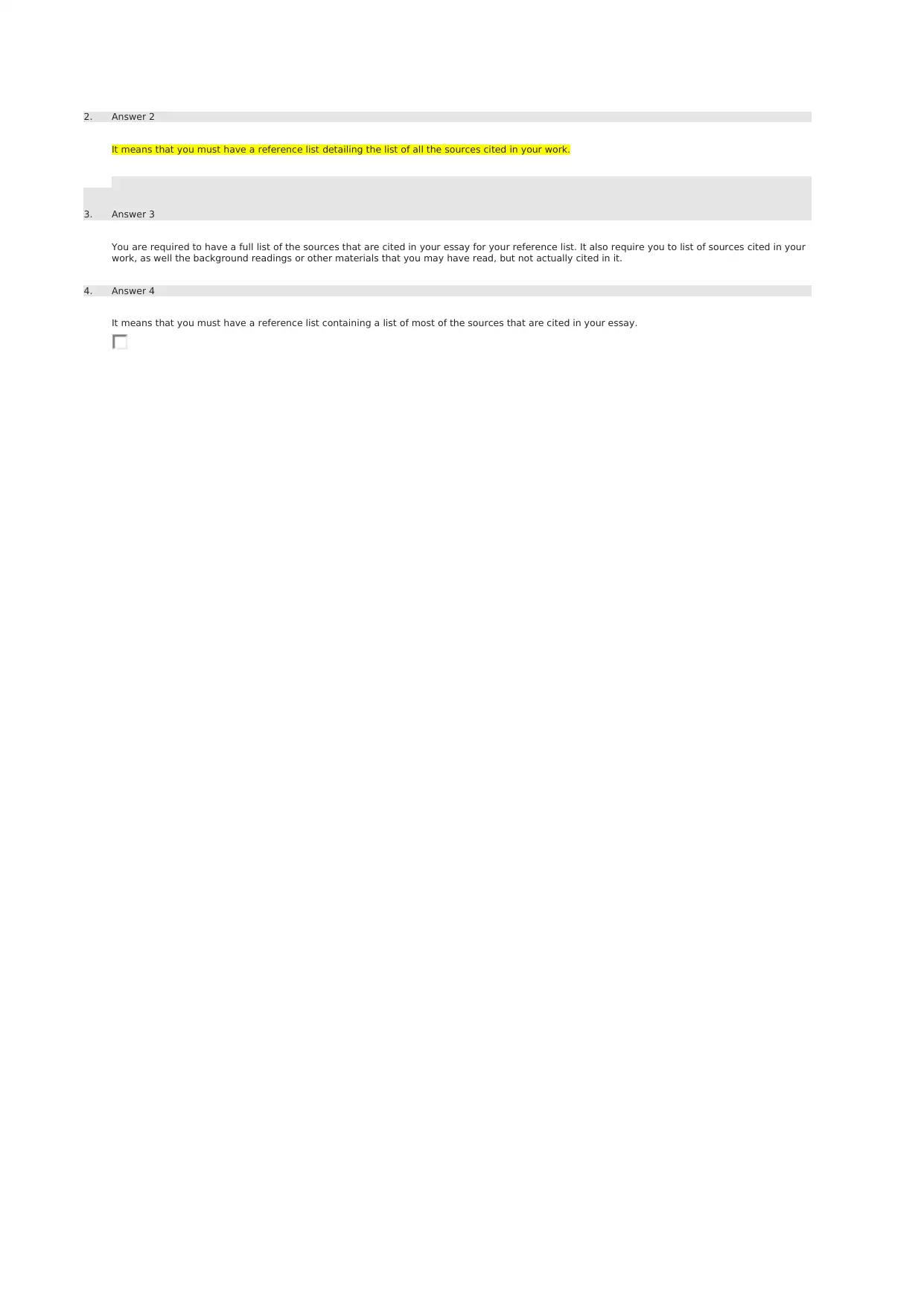
2. Answer 2
It means that you must have a reference list detailing the list of all the sources cited in your work.
3. Answer 3
You are required to have a full list of the sources that are cited in your essay for your reference list. It also require you to list of sources cited in your
work, as well the background readings or other materials that you may have read, but not actually cited in it.
4. Answer 4
It means that you must have a reference list containing a list of most of the sources that are cited in your essay.
It means that you must have a reference list detailing the list of all the sources cited in your work.
3. Answer 3
You are required to have a full list of the sources that are cited in your essay for your reference list. It also require you to list of sources cited in your
work, as well the background readings or other materials that you may have read, but not actually cited in it.
4. Answer 4
It means that you must have a reference list containing a list of most of the sources that are cited in your essay.
1 out of 7
Related Documents
Your All-in-One AI-Powered Toolkit for Academic Success.
+13062052269
info@desklib.com
Available 24*7 on WhatsApp / Email
![[object Object]](/_next/static/media/star-bottom.7253800d.svg)
Unlock your academic potential
© 2024 | Zucol Services PVT LTD | All rights reserved.




